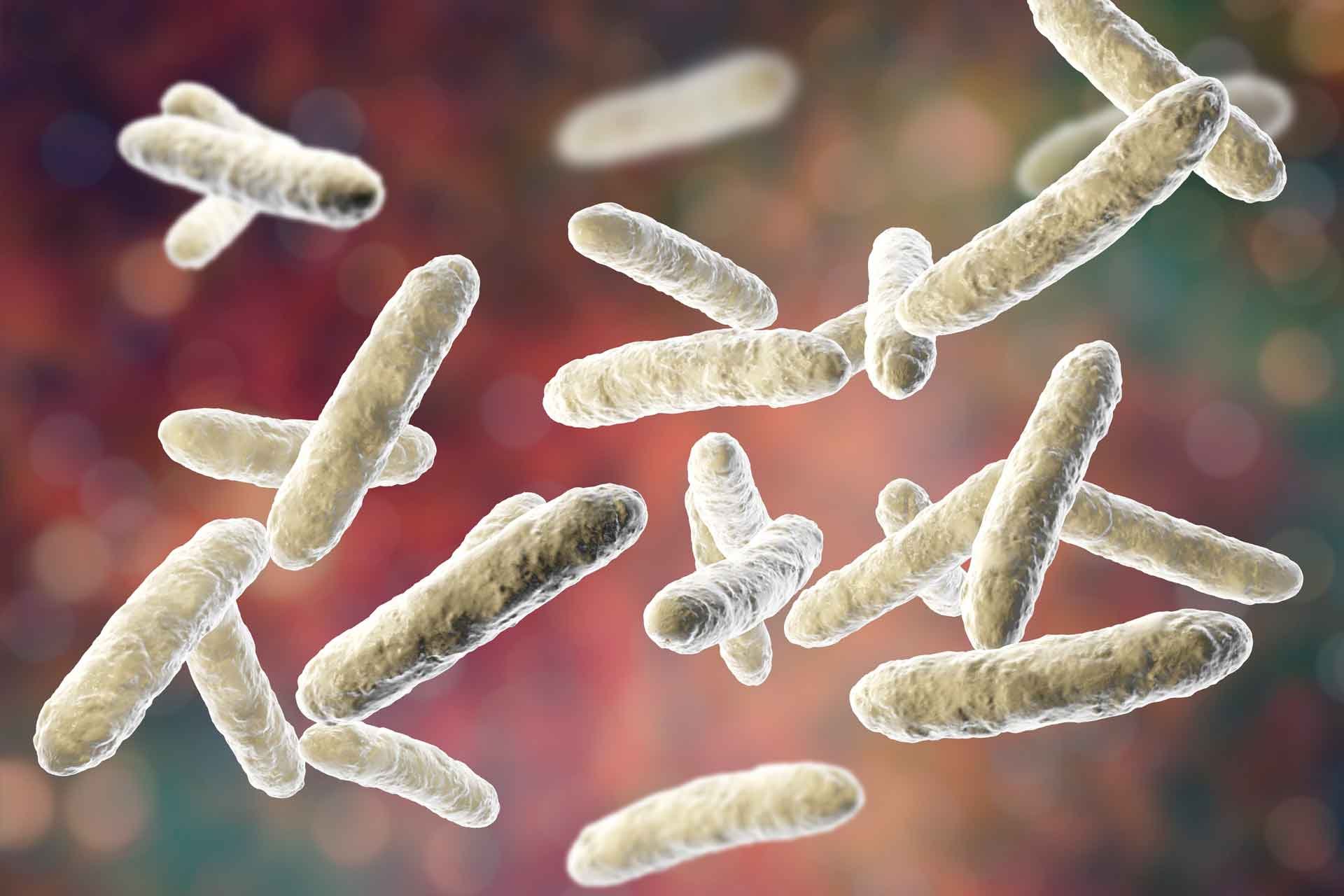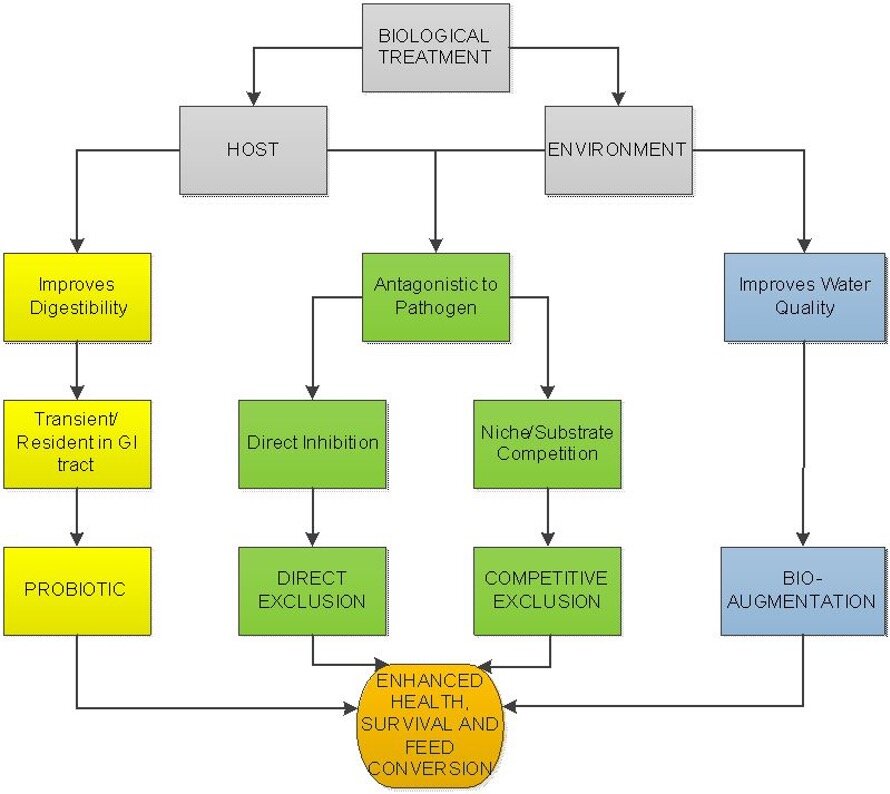Beginner’s Guide to Bacillus Use in Aquaculture
Bacillus 101
Bacillus is a genus of Gram-positive, rod-shaped, cylindrical bacteria that are widely found in soil, water and air. This genus includes a variety of species – some or beneficial members of various terrestrial and aquatic ecosystems, while others are harmful to other organisms.
Figure 1. Probiotic bacteria.
Members of this genus are highly adaptable and quite hardy due to their ability to form endospores – structures that protect them from a wide range of negative environmental conditions, including very high and very low temperatures, extreme dryness, radiation and toxic chemicals. Bacillus can remain dormant for years in this form and activate again once the conditions are favorable.
Aside from endospores, these incredible bacteria have a wide array of physiological abilities that help them to adapt to different environments and tolerate conditions that are deadly to many other organisms.
From Discovery to Today
Figure 2. Christian Gottfried Ehrenberg. Source: Wikimedia Commons.
The genus Bacillus was discovered in 1835 by Christian Gottfried Ehrenberg, German naturalist and microscopist, who was a prolific researcher in the 19th century. Ehrenberg’s younger colleague, Ferdinand Julius Cohn, later named the genus Bacillus, after the shape of these bacteria (bacillus means “stick” in Latin). He also found that these bacteria have two different forms – one that is not resistant to heat, and the one that is. This was the discovery of endospores and their incredible ability to withstand unfavorable environmental conditions.
Research continued in the following centuries, and as molecular methods improved, so did our knowledge of these versatile bacteria. Soon, it was discovered that some Bacillus species were able create useful metabolites and molecules that aid bioremediation of contaminated soils and water, as well as help plants and animals fight off pests and diseases – making them prime candidates for today’s aquaculture health industry.
Bacillus in aquaculture
Figure 3. Increased production of fishmeal and fish oil (FMFO) has a very negative impacts on marine biodiversity. Photo by: Lance Anderson
A growing world population and environmental concerns have placed significant pressures on the global food producers to provide sufficient high-quality, cost-effective food. In aquaculture, higher stocking densities have increased food production but also contributed to a higher occurrence of diseases and need for feed.
Aquaculture historically relied on the use of antibiotics to control the diseases and on fishmeal and fish oil (FMFO) feeds to meet these two challenges. However, studies are increasingly showing major problems with both antibiotic resistance and FMFO environmental effects.
To solve these two problems, scientists have increasingly turned to the natural allies of almost all multicellular organisms – beneficial bacteria (commonly referred to as probiotics).
Bacillus is a common beneficial bacteria for animal health applications due to four main characteristics:
Remarkable durability (due to its endospore structure)
Outstanding physiological abilities
Prolific enzyme activity
Rapid growth rate
But how exactly do these incredible bacteria have such a positive effect on growth and development of fish and crustaceans? Let’s find out.
What benefits do Bacillus provide in aquaculture?
Figure 4. Mechanisms of Bacillus Activity. https://cdn.intechopen.com/pdfs/46213.pdf
Either used as probiotics or for bioremediation of the water, Bacillus species have beneficial effects on multiple aspects of the aquaculture production process and offer long-term protection.
Here are a few of those major benefits, and the mechanism Bacillus strains use to accomplish them:
1. Improving water quality
Intensive aquaculture industries are very prone to poor water quality due to the high stocking densities and excessive feeding rates. The resulting accumulation of organic waste, nitrogen, and phosphorus simultaneously creates stressful conditions for fish and shrimps (which weakens their immune systems) and creates favorable environment for pathogens to thrive.
Figure 5. Summary of the mechanisms used by Bacillus in mitigating pathogens in aquaculture. Source: https://doi.org/10.1007/s10695-019-00754-y
Bacillus can stabilize water quality by accelerating waste cycling and increasing nutrient availability for fish and shrimps. These gram-positive bacteria use various carbohydrates as primary sources of energy. Compared to gram-negative bacteria, they are more efficient in metabolizing organic matter and turning it into CO2. As a result, Bacillus species are able to significantly reduce the accumulation of organic waste.
Accumulation of uneaten feed, feces, and organic residues cause increased levels of nitrates and phosphates in both freshwater and saltwater. This often results in higher incidence of disease and algal blooms.
Many choose to regulate water quality by adding more fresh water, but that practice negatively affects natural environments, as the wastewater is commonly released back into rivers and seas. Many Bacillus species are able to produce exo-enzymes that stimulate mineralization and enable nitrification and phosphate bioremediation of contaminated waters. By decreasing levels of ammonia, nitrite and phosphate ions, Bacillus species can amend water quality and provide a healthy environment for fish, shellfish and shrimps.
Species that are commonly used for water quality improvement include Bacillus amyloliquefaciens, B. licheniformis, B. subtilis, B. polymyxa, B. laterosporus and B. circulans.
2. Direct Inhibition of Disease
Some Bacillus species (for example, B. subtilis, B. mycoides,) are found naturally in the gut microbiome of some fish and can play an important role in fighting off pathogens.
These species can produce compounds with inhibitory properties which give them competitive advantage against other potentially harmful bacteria. Bacteriocins are small peptides that display antibiotic activity and can be successfully used for treating antibiotic-resistant bacteria.
Aside from bacteriocins, Bacillus can also produce antibiotics; Antibiotic production is a very important mechanism Bacillus use to fight off other bacteria – around 4-5% of B. subtilis genome is devoted to production of antibiotics only. Bacillus is able to produce a wide range of antibiotics that are effective against many different bacteria and even viruses. Many will ask if these compounds contribute to antibiotic resistance, and the simple answer is yes. However, considering that Bacillus uses a combination of different mechanisms and not just this one, the incidence of microbial resistance to antibiotics is significantly less likely compared to traditional application of these compounds.
Many Bacillus species also are known for their intensive lytic activity, which increases the availability of nutrients in the gut, and also has antimicrobial properties. Lytic enzymes can degrade the cell wall of pathogenic bacteria, which causes them to die off. However, more research needs to be done on this subject, as beneficial bacteria can also be affected by these enzymes due to their low specificity.
Species that are used for this purpose include Bacillus subtilis, B. licheniformis, B. coagulans, and B. amyloliquefaciens.
3. Immunostimulation / Indirect Inhibition of Disease
Aside from inhibitors, Bacillus also produce compounds that can stimulate natural immune responses and indirectly prevent disease growth in the long term.
Many Bacillus strains have powerful tools that help them successfully compete with other microorganisms. One of those tools is quorum quenching – suppression of virulence gene expression – where compounds are produced which block signaling molecules necessary for activation of the virulence gene in pathogenic bacteria. This way, even if the pathogenic bacteria are present, these bacillus strains will disrupt their signaling mechanisms and prevent them from causing any greater harm to their host. This mechanism helps these bacillus species to outcompete harmful bacteria and bring balance to the gut microbiome of fish and shrimps.
Adhesion sites are surfaces on the host’s tissue where bacteria can attach and establish colonies. In order to infect the host, pathogenic bacteria need to attach to these sites. Bacillus, along with other probiotic cultures, can prevent this in certain aquatic species. While evidence is still building on specific applications, the belief is that these strains colonize the gut, leaving no space for pathogens, thus physically disabling them from establishing.
Lastly, Bacillus and pathogenic bacteria use similar sources of nutrients. Considering that Bacillus has a faster growth rate than most pathogens, they often outcompete them and decrease the amount of food available to them. Starved of nutrients, the pathogens grow weak and become more sensitive to the effects of compounds and enzymes Bacillus produces.
4. Improving growth and feed utilization
One of the most important tasks in aquaculture today is to reduce the use of FMFO.
Feed is the most expensive part of aquaculture production process, both economically and environmentally. Most feeds used in aquaculture are obtained by draining marine resources and overharvesting wild fish, which threatens to severely decrease biodiversity and disrupt entire ecosystems. With almost a fifth of the world’s total wild fish catch used for producing FMFO only, the fishmeal industry heavily relies on harvesting in areas that have low levels of governance (Asia, Africa, Latin America) and very few regulations regarding the exploitation of fish and crustaceans.
These frequent population declines of small forage fish and crustaceans have a detrimental effect on species that depend on them – seabirds, marine mammals, larger fish and many other. Marine ecosystems are highly complex, and it has been shown that local ecosystems can be severely damaged by FMFO production and overharvesting.
Similar to probiotic usage in humans, aquaculture probiotics have been studied to isolate their ability to help aquatic animals to utilize nutrients more efficiently. By enabling more efficient utilization of nutrients, some Bacillus strains can decrease the feed needs, improving feed conversion rate and lowering the price of production.
Aside from directly increasing the availability of nutrients with its metabolic activity, its immune-enhancing and water bioremediation abilities can increase the growth of mature fish and survival rate of larvae, leading to improved Feed Conversion Rates.
Conclusion
Bacillus uses a wide array of mechanisms to drive significant benefits for aquaculture production – in a sustainable, natural manner. These bacteria stimulate nutrient cycling, which both increases the quality of the water and nutrient availability for fish and shrimps. By competing for space and nutrients, and producing various enzymes, bacteriocins and antibiotics, Bacillus is able to outcompete pathogenic bacteria and provide health benefits to many aquatic species. Last, they have the advantage of being living organisms; as a result, they can establish and reproduce on their own and provide long-term protection.





